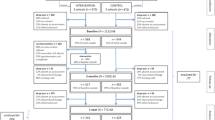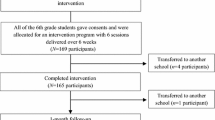Abstract
Aim
Disordered eating is a significant social and economic issue in Western societies. Weight and shape concerns are highly prevalent during adolescence and an alarming percentage of adolescents already show disturbed eating patterns. Sociocultural factors like the beauty ideal promoted by the media and social agents are among the main reasons for this trend. Prevention programmes which focus on established protective and risk factors are needed to counteract problematic developments as early as possible.
Subject and methods
In this paper we describe the development and the contents of a structured school-based eating disorder prevention programme for adolescents.
Results
The POPS programme (POtsdam Prevention at Schools) is an interactive multisession programme and encompasses nine lessons for pupils and one meeting with the parents. The programme is based on current research on risk and protective factors for eating disorders with an emphasis on sociocultural factors. It is designed to enhance resources based on the life skills approach. We included for instance lessons to enhance healthy eating and exercise habits and to reduce unhealthy dieting, to build up resistance through media literacy and strategies to react to social pressure. To further enhance life skills we integrated the impartation of problem-solving techniques and coping strategies which are potential protective factors not only in relation to eating disorders but also other diseases. In contrast to most existing programmes, psychoeducation on eating disorders is not part of the POPS programme for pupils but part of the information session for the parents.
Conclusion
POPS is a theory-based, structured prevention programme that can be implemented by teachers as part of regular lessons.


Similar content being viewed by others
References
Agras WS, Bryson S, Hammer LD, Kraemer HC (2007) Childhood risk factors for thin body preoccupation and social pressure to be thin. J Am Acad Child Adolesc Psychiatry 46:171–178
American Psychiatric Association (2000) Diagnostic and statistical manual of mental disorders, 4th edn, text revision (DSM-IV-TR). American Psychiatric Association, Washington
Aschenbrenner K, Aschenbrenner F, Kirchmann H, Strauß B (2004) Störungen des Essverhaltens bei Gymnasiasten und Studenten. Psychother Psychosom Med Psychol 54:259–263
Becker CB, Bull S, Schaumberg K, Cauble A, Franco A (2008) Effectiveness of peer-led eating disorders prevention: a replication trial. J Consult Clin Psychol 76:347–354
Becker CB, Smith LM, Ciao AC (2005) Reducing eating disorder risk factors in sorority members: a randomized trial. Behav Ther 36:245–253
Berger U, Ziegler P, Strauß B (2008) PriMa für Barbie: Evaluation eines Programms zur Primärprävention von Magersucht bei Mädchen ab der 6. Klasse. Z Psychosom Med Psychother 54:32–45
Berkman ND, Lohr KN, Bulik CM (2007) Outcomes of eating disorders: a systematic review of the literature. Int J Eat Disord 40:293–309
Berkman ND, Bulik CM, Brownley KA, Lohr KN, Sedway JA, Rooks A, Gartlehner G (2006) Management of eating disorders. Evid Rep Technol Assess (Full Rep) 135:1–166
Botvin GJ, Griffin KW (2004) Life skills training: empirical findings and future directions. J Prim Prev 25:211–232
Budd GM, Volpe SL (2006) School-based obesity prevention: research, challenges, and recommendations. J Sch Health 76:485–495
Buddeberg-Fischer B, Reed V (2001) Prevention of disturbed eating behavior: an intervention program in Swiss high school classes. Eat Disord 9:109–124
Carter JC, Stewart DA, Dunn VJ, Fairburn CG (1997) Primary prevention of eating disorders: might it do more harm than good? Int J Eat Disord 22:167–172
Chamay-Weber B, Narring F, Michaud P (2005) Partial eating disorders among adolescents: a review. J Adolesc Health 37:417–427
Cohen SB (2006) Media exposure and the subsequent effects on body dissatisfaction, disordered eating, and drive for thinness: a review of the current research. Mind Matters Wesleyan J Psych 1:57–71
Crowther JH, Armey M, Luce KH, Dalton GR, Leahey T (2008) The point prevalence of bulimic disorders from 1990 to 2004. Int J Eat Disord 41:491–497
Dannigkeit N, Köster G, Tuschen-Caffier B (2005) Ist primäre Prävention von Essstörungen langfristig wirksam? Ergebnisse zur Evaluation eines Trainingsprogramms an Schulen. Z Gesundheitspsychol 13:79–91
Davison TE, McCabe MP (2006) Adolescent body image and psychosocial functioning. J Soc Psychol 146:15–30
Dominé F, Berchtold A, Akré Ch, Michaud PA, Suris JC (2009) Disordered eating behaviors: what about boys? J Adolesc Health 44:111–117
Fagan AA, Mihalic S (2003) Strategies for enhancing the adoption of school-based prevention programs: lessons learned from the blueprints for violence prevention replications of the life skills training program. J Community Psychol 31:235–253
Fingeret MC, Warren CS, Cepeda-Benito A, Gleaves DH (2006) Eating disorder prevention research: a meta-analysis. Eat Disord 14:191–213
Groesz LM, Levine MP, Murnen SK (2002) The effect of experimental presentation of thin media images on body satisfaction: a meta-analytic review. Int J Eat Disord 31:1–16
Hautala LA, Junnila J, Helenius H, Väänänen AM, Liuksila PR, Räihä H, Välimäki M, Saarijärvi S (2008) Towards understanding gender differences in disordered eating among adolescents. J Clin Nurs 17:1803–1813
Herpertz-Dahlmann B, Wille N, Hölling H, Vloet TD, Ravens-Sieberer U (2008) Disordered eating behaviour and attitudes, associated psychopathology and health-related quality of life: results of the BELLA study. Eur Child Adolesc Psychiatry 17:82–91
Hoek HW, van Hoeken D (2003) Review of the prevalence and incidence of eating disorders. Int J Eat Disord 34:383–396
Hoek HW (2006) Incidence, prevalence and mortality of anorexia nervosa and other eating disorders. Curr Opin Psychiatry 19:389–394
Hölling H, Schlack R (2007) Essstörungen im Kindes- und Jugendalter. Erste Ergebnisse aus dem Kinder- und Jugendgesundheitssurvey (KiGGS). Bundesgesundheitsblatt Gesundheitsforschung Gesundheitsschutz 50:794–799
Jacobi C, Hayward C, de Zwaan M, Kraemer HC, Agras SW (2004) Coming to terms with risk factors for eating disorders: application of risk terminology and suggestions for a general taxonomy. Psychol Bull 130:19–65
Jerusalem M, Weber H (2003) Psychologische Gesundheitsförderung – Diagnostik und Prävention. Hogrefe, Göttingen
Jones JM, Bennett S, Olmsted MP, Lawson ML, Rodin G (2001) Disordered eating attitudes and behaviours in teenaged girls: a school-based study. CMAJ 165:547–552
Keel PK, Haedt A (2008) Evidence-based psychosocial treatments for eating problems and eating disorders. J Clin Child Adolesc Psychol 37:39–61
Killen JD, Taylor CB, Hammer LD, Litt I, Wilson DM, Rich T, Hayward C, Simmonds B et al (1993) An attempt to modify unhealthy eating attitudes and weight regulation practices of young adolescent girls. Int J Eat Disord 13:369–384
Levine MP, Smolak L (2006) The prevention of eating problems and eating disorders. Theory, research, and practice. Lawrence Erlbaum Associates, Mahwah
Mann T, Nolen-Hoeksema S, Huang K, Burgard D, Wright A, Hanson K (1997) Are two interventions worse than none? Joint primary and secondary prevention of eating disorders in college females. Health Psychol 16:215–225
Menzel JE, Schaefer LM, Burke NL, Mayhew LL, Brannick MT, Thompson JK (2010) Appearance-related teasing, body dissatisfaction, and disordered eating: a meta-analysis. Body Image 7:261–270
Muise AM, Stein DG, Arbess G (2003) Eating disorders in adolescent boys: a review of the adolescent and young adult literature. J Adolesc Health 33:427–435
Nation M, Crusto C, Wandersman A, Kumpfer KL, Seybolt D, Morrissey-Kane E, Davino K (2003) What works in prevention. Principles of effective prevention programs. Am Psychol 58:449–456
Neumark-Sztainer D, Hannan PJ (2000) Weight-related behaviors among adolescent girls and boys: results from a national survey. Arch Pediatr Adolesc Med 154:569–577
Neumark-Sztainer D, Story M, Hannan PJ, Perry CL, Irving LM (2002) Weight-related concerns and behaviors among overweight and nonoverweight adolescents: implications for preventing weight-related disorders. Arch Pediatr Adolesc Med 156:171–178
O’Dea J (2000) School-based interventions to prevent eating problems: first do not harm. Eat Disord 8:123–130
O’Dea J (2002) Can body image education programs be harmful to adolescent females? Eat Disord 10:1–13
O’Dea J, Maloney D (2000) Preventing eating and body image problems in children and adolescents using the health promoting schools framework. J Sch Health 70:18–21
Piran N (2004) Teachers: on “being” (rather than “doing”) prevention. Eat Disord 12:1–9
Polivy J, Herman CP (2002) Causes of eating disorders. Annu Rev Psychol 53:187–213
Ricciardelli LA, McCabe MP (2004) A biopsychosocial model of disordered eating and the pursuit of muscularity in adolescent boys. Psychol Bull 130:179–205
Ricciardelli LA, McCabe MP, Banfield S (2000) Sociocultural influences on body image and body change methods. J Adolesc Health 26:3–4
Rosen DS, American Academy of Pediatrics Committee on Adolescence (2010) Identification and management of eating disorders in children and adolescents. Pediatrics 126:1240–1253
Simon J, Schmidt U, Pilling S (2005) The health service use and cost of eating disorders. Psychol Med 35:1543–1551
Stice E, Maxfield J, Wells T (2003) Adverse effects of social pressure to be thin on young women: an experimental investigation of the effect of “fat talk”. Int J Eat Disord 34:108–117
Stice E, Shaw H (2004) Eating disorder prevention programs: a meta-analytic review. Psychol Bull 130:206–227
Stice E, Shaw H, Marti CN (2007) A meta-analytic review of eating disorder prevention programs: encouraging findings. Annu Rev Clin Psychol 3:207–231
Striegel-Moore RH, DeBar L, Wilson GT, Dickerson J, Rosselli F, Perrin N, Lynch F, Kraemer HC (2008) Health services use in eating disorders. Psychol Med 38:1465–1474
Wade TD, Lowes J (2002) Variables associated with disturbed eating habits and overvalued ideas about the personal implications of body shape and weight in a female adolescent population. Int J Eat Disord 32:39–45
Warschburger P (2009) Körperunzufriedenheit und gestörtes Essverhalten bei Jugendlichen. Prax Klin Verhaltensmed Rehabil 85:152–158
Wilson GT, Grilo CM, Vitousek KM (2007) Psychological treatment of eating disorders. Am Psychol 62:199–216
Yager Z, O’Dea JA (2005) The role of teachers and other educators in the prevention of eating disorders and child obesity: what are the issues? Eat Disord 13:261–278
Conflict of interest
The authors declare that they have no conflict of interest.
Funding
The development and evaluation of the POPS programme was supported by a grant from the Federal Ministry of Education and Research (Bundesministerium für Bildung und Forschung 01EL0607) to Prof. Dr. Petra Warschburger. The funder played no role in any phase of writing this paper and the views expressed are solely those of the authors.
Author information
Authors and Affiliations
Corresponding author
Rights and permissions
About this article
Cite this article
Warschburger, P., Helfert, S. & Krentz, E.M. POPS: a school-based prevention programme for eating disorders. J Public Health 19, 367–376 (2011). https://doi.org/10.1007/s10389-011-0425-3
Received:
Accepted:
Published:
Issue Date:
DOI: https://doi.org/10.1007/s10389-011-0425-3




